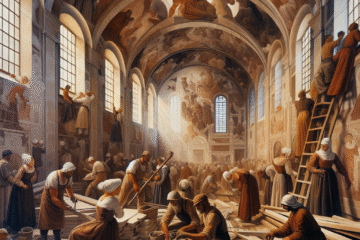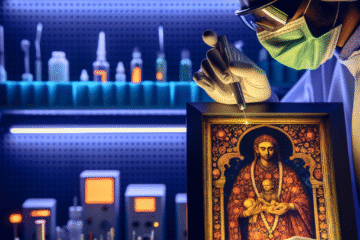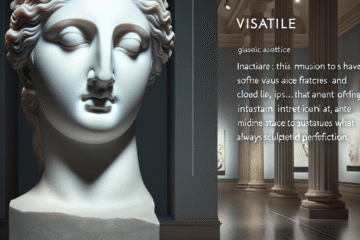Introduction: Redefining the Work of Art
For centuries, visual art was predominantly an exercise in framing—a painting on a wall, a sculpture on a pedestal, an image fixed in time and space, inviting contemplation but keeping the viewer at a respectful distance. The rise of installation art shattered these boundaries. Emerging in the 20th century and evolving rapidly into the 21st, installation art immerses viewers into environments that blur the line between object and observer. It calls not just for sight but presence, not merely perception but participation. This transformation reflects broader cultural shifts—towards interactivity, towards the experiential, and towards an understanding of art as lived rather than viewed. Installation art is not just about occupying space; it is about reshaping our perception of time, narrative, and reality itself.
Chapter I: From Tableau to Environment – The 20th Century Breakaway
The roots of installation art can be traced to early 20th-century movements that challenged the conventions of traditional aesthetic experience. Artists associated with Dada and Surrealism, such as Marcel Duchamp and Kurt Schwitters, began to question the sanctity of the art object. Duchamp’s “readymades”—everyday objects recontextualized as art—hinted at the conceptual revolution to come. But it was Allan Kaprow’s “Happenings” in the 1950s and 60s that initiated a seismic shift. These participatory performance events broke down the barrier between artist and audience, making the viewer an integral component of the artwork itself.
Meanwhile, artists like Yayoi Kusama brought repetition and immersive environments into the gallery space, as seen in her Infinity Mirror Rooms. Moving beyond painting or sculpture, she crafted sensorial experiences that enveloped the viewer, evoking altered states of perception. The artistic space was no longer a neutral container; it became a stage, a protagonist, and sometimes, the artwork itself.
Chapter II: Minimalism, Conceptualism, and the Spatial Turn
By the 1960s and 70s, two critical movements—Minimalism and Conceptual Art—further drove the evolution towards installation. Artists like Donald Judd, Dan Flavin, and Carl Andre emphasized spatial relationships through geometric simplicity and industrial materials. Their works occupied space deliberately and unavoidably, confronting viewers as physical presences rather than illusions. At the same time, Conceptual artists such as Sol LeWitt and Lawrence Weiner focused on the primacy of ideas over the art object, which encouraged artists to use space as a field in which ideas could manifest experientially.
This era also saw Robert Morris’s mirrored rooms and James Turrell’s light installations, pushing further into the manipulation of perception. These artworks unfolded in real time as viewers moved through and around them, introducing the dimension of time as an integral part of the artistic experience—what some began to refer to as ‘the fourth dimension.’
Chapter III: The Rise of Immersion – Technology and Sensory Engagement
With the late 20th and early 21st centuries came rapid technological advancements that transformed how artists could interact with space and time. The emergence of video, sound projection, and digital tools enabled a new level of multisensory engagement. Pioneers like Bill Viola used slow-motion video and sound to create meditative, chapel-like installations that redefined the temporal scale of art appreciation.
Meanwhile, the proliferation of digital technologies brought entirely new platforms for interactivity. Rafael Lozano-Hemmer’s technologically mediated environments respond to biometric data such as breath and heartbeat—literalizing the concept of the artwork as alive to viewer presence. TeamLab, a Japanese interdisciplinary collective, has become renowned for its immersive digital environments that react in real-time to visitor movements, rendering the distinction between space, light, and viewer practically irrelevant.
Chapter IV: Philosophies of Presence – Time, Being, and Reality
The rise of installation art runs parallel with a growing philosophical discourse around time, being, and lived experience. Martin Heidegger’s existential ontology, particularly his focus on ‘Dasein’ (being-there), resonates deeply with the immersive demands of installation. By requiring the viewer’s embodied presence, installation art embodies Heidegger’s assertion that meaning emerges through being-in-the-world. Maurice Merleau-Ponty’s phenomenology, emphasizing bodily perception and spatiality, also provides a crucial framework for understanding the impact of these works.
In installations, space is not just geographic—it becomes psychological and emotional. Works like Christian Boltanski’s environments of flickering lights and personal artifacts evoke ghosts of memory and mortality, turning space into a vessel of collective consciousness. The temporality of these works—ephemeral, shifting, vanishing after the exhibition—also invites reflection on impermanence and the transitory nature of existence itself.
Chapter V: The Future of Embodied Art – From Virtual Reality to Environmental Activism
As we move deeper into the digital age, installation art continues to push boundaries. Virtual reality (VR) and augmented reality (AR) are opening up new dimensions—both literally and conceptually. Artists like Laurie Anderson and Marina Abramović have begun to explore these immersive platforms, turning inner psychological experiences into navigable virtual landscapes. In these works, space is no longer a constraint but an infinite frontier.
At the same time, many installation artists are turning towards issues of ecology and sustainability. Olafur Eliasson’s large-scale weather-inspired installations, such as ‘The Weather Project’ at Tate Modern, create awe-inspiring environments that provoke existential reflection on climate change and the human relationship to nature. Here, the fourth dimension includes not just time but crisis—the urgency of now manifest in spatial form.
Conclusion: Art for the Whole Sensorium
Installation art challenges us to reconsider what art is and what it can do. By engaging all our senses, by activating our awareness of time and space, and by inviting interaction and presence, it opens up art’s fourth dimension—a democratic, dynamic field where experience itself becomes the medium. The traditional frame has dissolved, and in its place is a living world that asks not only to be seen but to be entered, felt, and remembered. As art continues to evolve in response to technological, cultural, and ecological tides, installation art will likely remain at the vanguard—charting new frontiers not just in aesthetics, but in consciousness itself.


